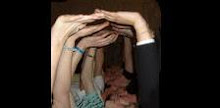
AUM BHOOR BHUWAH SWAHA,
TAT SAVITUR VARENYAM
BHARGO DEVASAYA DHEEMAHI
DHIYO YO NAHA PRACHODAYAT.
Summary of the Gayatri Mantra
Gayatri Mantra (the mother of the vedas), the foremost mantra in hinduism and hindu beliefs, inspires wisdom. Its meaning is that "May the Almighty God illuminate our intellect to lead us along the righteous path". The mantra is also a prayer to the "giver of light and life" - the sun (savitur).
Oh God! Thou art the Giver of Life,
Remover of pain and sorrow,
The Bestower of happiness,
Oh! Creator of the Universe,
May we receive thy supreme sin-destroying light,
May Thou guide our intellect in the right direction.
Word for Word Meaning of the Gayatri Mantra
Aum = Brahma ;
bhoor = embodiment of vital spiritual energy(pran) ;
bhuwah = destroyer of sufferings ;
swaha = embodiment of happiness ;
tat = that ;savitur = bright like sun ;
varenyam = best choicest ;
bhargo = destroyer of sins ;
devasya = divine ;
these first nine words describe the glory of God
dheemahi = may imbibe ;
pertains to meditationdhiyo = intellect ;
yo = who ;naha = our ;
prachodayat = may inspire!
"dhiyo yo na prachodayat" is a prayer to God

Origin, Benefits and Chanting of the Gayatri Mantra
The Vedas are widely considered to be the source of all true knowledge, the word "Veda" itself meaning "Knowledge". Gayatri Devi also gave to mankind the "Gayatri Mantra", also known as the "Guru Mantra" or the "Savitri Mantra". It is one of the oldest mantras, and generally thought of as being amongst the highest and most powerful mantras of all. This mantra is therefore often referred to as "the Mother of the Vedas". In the Bhagavad Gita, Lord Krishna had proclaimed to Arjuna - "Among all the mantras, I am the Gayatri".
Rishis selected the words of the Gayatri Mantra and arranged them so that they not only convey meaning but also create specific power of righteous wisdom through their utterance. The ideal times for chanting the mantra are three times a day - at dawn, mid-day, and at dusk. These times are known as the three sandhyas - morning, mid-day and evening. The maximum benefit of chanting the mantra is said to be obtained by chanting it 108 times. However, one may chant it for 3, 9, or 18 times when pressed for time. The syllables of the mantra are said to positively affect all the chakras or energy centres in the human body - hence, proper pronunciation and enunciation are very important.
Chanting of Gayatri Mantra removes all obstacles in our path to increased wisdom and spiritual growth and development. The teachings and powers incorporated in the Gayatri Mantra fulfill this purpose. Righteous wisdom starts emerging soon after Jap(recitation) of the Gayatri Mantra is performed. Sathya Sai Baba teaches that the Gayatri Mantra "will protect you from harm wherever you are, make your intellect shine, improve your power of speech, and dispel the darkness of ignorance (Dhiyoyonah prachodayaath)"
Women & Gayatri Mantra
Generally it is said that when women chant they should start from the 2nd line.
The Gayatri is a 24-syllable hymn from the Rig Veda (III, 62, 10). The phrase Om Bhoor Bhuvah Svah is generally added when the mantra is recited. The Sanskrit word Gayatri is formed by two words, ganat (or gayanath), which means "that which is sung," and trayate, which means "that which delivers." In other words, the Gayatri is a song of deliverance.
Some other books says :
Gāyatrī = Gāya + Trī.
Gāya is derived from Ga
Trī = Female defender.
Tra = Trā = male defender,
Gāya = song; Gāyak = singer; Gāyan = singing
Gāyatrī / Gayatri = Song that protects; Gayatri Devi is the protector.
Gāyatrī = Gāya + Trī.
Gāya is derived from Ga
Trī = Female defender.
Tra = Trā = male defender,
Gāya = song; Gāyak = singer; Gāyan = singing
Gāyatrī / Gayatri = Song that protects; Gayatri Devi is the protector.
The five graces of God or Gayatri are also His or Her names: SadyojAta, Vamadeva, Tat Purusha, Isana, and Aghora.
SadyojAta: Sadyo + jAta = fresh + brought into existence, born = Creator.
VAmadeva: VAma + Deva = pleasant, agreeable, fair + god = preserver.
VAmadeva: VAma + Deva = pleasant, agreeable, fair + god = preserver.
Tatpurusha: Tat + Purusha = That + man = Original or Supreme Spirit.
IsAna: The grace-giving form of Siva, Sadasiva. He is invisible to the human eye
Aghora: Not terrific. Destructive aspect of Siva as prelude to regeneration. It is fire that is followed by new growth.
IsAna: The grace-giving form of Siva, Sadasiva. He is invisible to the human eye
Aghora: Not terrific. Destructive aspect of Siva as prelude to regeneration. It is fire that is followed by new growth.
It is the most renowned mantra of the Vedas. It is addressed to the divine life-giver as supreme God, symbolized in Savitri, the Sun. For this reason this prayer is also called Savitri.
Tat Savitur
Savitur is radiant brilliance shinning forth from nowhere.
Savitur must not be regarded as only the light of the solar sun.
Savitur is radiant brilliance shinning forth from nowhere.
Savitur must not be regarded as only the light of the solar sun.
Often our solar sun is said to symbolizes Savitur, the illuminator of existence. The light of the solar sun may be a symbol for Savitur however the sun can not actually be Savitur.
Let us examine the Mantra. Here is how it starts:
It is "Tat Savitur" with which the Mantra begins.
It is "Tat Savitur" which is the body of the Mantra.
Also the appeal of the Mantra is directed to "Tat Savitur".
Explanation:
Tat Savitur is "The essential Illuminator"
The brilliance inherent in cognition, in perception.
"That" which illuminates the three worlds.
Tat Savitur is "The essential Illuminator"
The brilliance inherent in cognition, in perception.
"That" which illuminates the three worlds.
The three worlds:
1.Existence (the imaginary, the apparent, material, physical and all that it contains).
2. Consciousness (the field of cognition, infinity and eternity and all that may occur within it).
3.Totality (the incomprehensible, un-dividable, Absolute, Potential.)
1.Existence (the imaginary, the apparent, material, physical and all that it contains).
2. Consciousness (the field of cognition, infinity and eternity and all that may occur within it).
3.Totality (the incomprehensible, un-dividable, Absolute, Potential.)
The Solar Sun is perceived by the power of Tat Savitur. It is not Tat Savitur.
When all the stars and solar systems in space have died away, Tat Savitur will again be the illuminator of what may, what can, be experienced, forever.
If it were not so, the mantra would not appeal for the Enlightened Awareness for all.
It is Enlightenment, which empties out every last trace of appearance or concept that may be perceived. Including the Solar Sun and all that it nurtures. This mantra speaks of a power that is itself beyond (and immanently saturates) the perceivable and im-perceivable cosmos. Life as it is experienced.
The Gayatri Mantra is extremely powerful and its divine implications are not easily comprehended. The Mantras power is so universal in scope that we can not confine it to actually understanding it's subtle nuances. The language of the mantra is a more symbolic and metaphysical one. It is similar to Enlightenment, Impossible to understand and yet so very intimately present.
The three worlds, Bhūr, bhuvar [or bhuvah], svar are the habitats of men and gods. It is confluence of body, mind and soul. In a subjective sense, life on earth is waking; life in the atmospheric domain, dream sleep; life in heaven, deep sleep. A note: Man in deep sleep is the Purest Being known to man; he gives up all good, bad, and indifferent deeds of his awake life; thus, a man in deep sleep is a spiritual being or the purest being; he is in touch with his God in deep sleep; thus deep sleep is heaven. Have you ever heard of a thief stealing or planning to steal in deep sleep? Here is another example. The man holding on an umbrella when awake is the man with worldly attachments; the man (dozing off in a moving train) going to sleep lets go of his umbrella and gets in touch with his god in deep sleep. When he comes out of deep sleep, he is disconnected from his God and temporary bliss and looks for his loose umbrella (lying on the floor of the moving train). When we are in deep sleep, we are awake to the world of Spirit. The progression is from spiritually marginal condition of awake life (Bhūr, Earthly life) full of desires, to a dream world of aspirations and expectations of Bhuvar, and to the world of deep sleep of Svar (heaven), where flesh dies along with desires, and spirit rises. When we are in deep sleep we are all virtuous (Sattva); when we come back to awake life, we resume our old personality which is a combination of Sattva (virtue and goodness; the quality of truth, goodness, reality, purity), Rajas (motion, passion, desire), and Tamas (darkness, ignorance, heaviness, illusion, anger, pride, sorrow, dullness, solidity [dense]).



article was superb... read hanuman chalisa friends
ReplyDelete